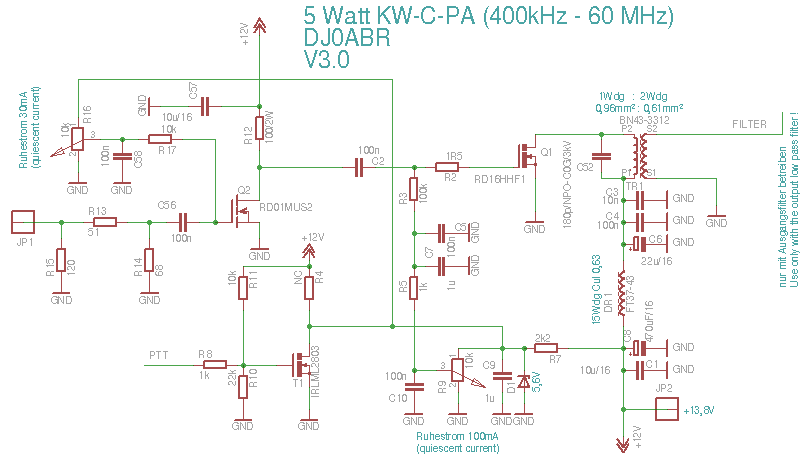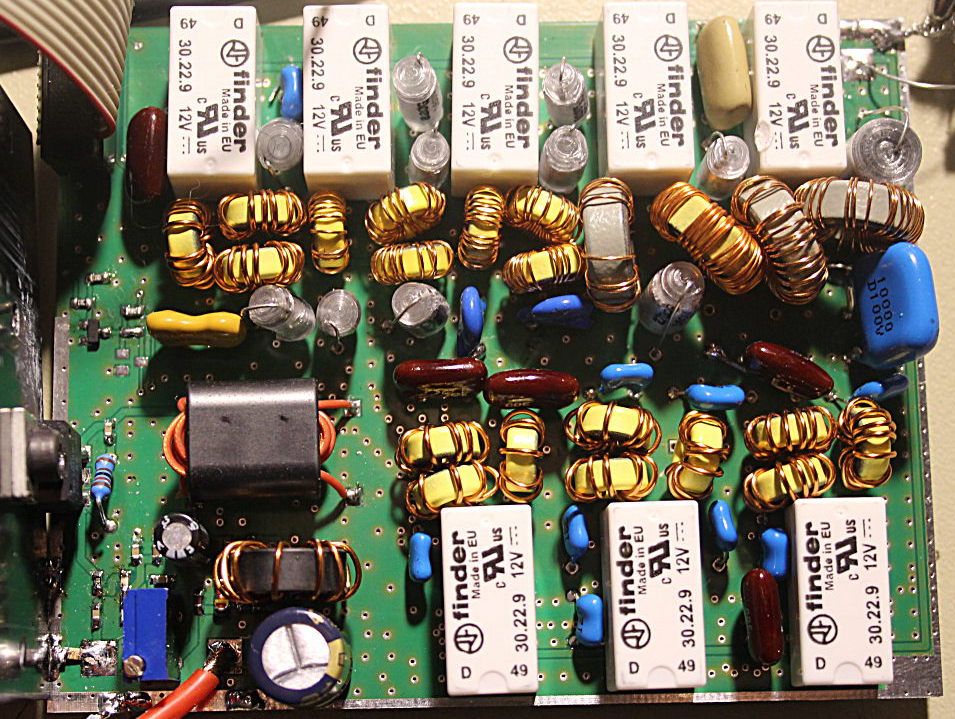
This amp is ideal for WSPR where generally we work with power levels up to 5 Watts. It is also especially useful for CW transmitters as to our knowledge it is the smalls QRP final amplifier worldwide that includes filters for 11 Ham Bands !
Highlights:
* more than 5 Watt from 400kHz to 54MHz
* continious amplification of 18 dB from median wave and short wave to 6 meters
* 8 AFU Low Pass filters for 11 bands with automatic band switching by relay
* Class C operation with selectable idle current for good efficiency
* usable with 13.8V battery for Field Day or portable ops etc.
Circuit:
The amp uses the HF MOSFET RD16HHF1. This is a 16W transistor which as reserves when utilized at 5 to 8 Watts and therefore can work with poor impedance matches.Indeed during the design phase I did not baby this transistor and it survived everything. Due to the high efficiency one usually does not need a heat sink. The side of the metal case is sufficient. Only when operating in a continuous mode like digital SSTV one should apply additional cooling.
(click to enlarge):
The Bill of Material see HERE.
The amp is fed through a capacitor. By not using a transformer we are able to cover the wide frequency operation from 0.4 to 54 MHz. As the MOSFET has high impedance we utilize a 56 Ohm resister (R3) to match the impedance. At higher frequencies the match gets worse but still good enough for our use. One needs an input power of about 100 mW which will yield 5W on all bands.
If one needs more power then the supply voltage can be increase and 10 Watts can be achieved easily.The feedback R1 is not used. Only if one wants to utilize the amp also for SSB mode a 330 Ohm resister should be added there and the idle current increased. That way the amp will work in Class A operation andbecomes linear, however amplification and efficiency will be reduced.For normal operation adjust the idle current to 100 mA (R9).
Very important is the compensation capacitor C52 . It needs to be a mica type cap. Its purpose is to compensate the tendency to over oscillate in Class C operation and create a normal wave form. Without that capacitor one would get lots of harmonics and almost no output power.The output power is decoupled with a 1:4 transformer (winding rate 1:2). The ferrite choke DR1 keeps the RF from the supply voltage.
Using the PTT input one can turn off the idle current when not transmitting which saves energy. Depending on the polarity of the PTT input one uses T2 and leaves R6 unconnected, or leave T2 off and bridges R6. In most cases however PTT will be connected to ground when transmitting. In this case leave T2 out and bridge R6.The amp requires up to 1A current at 13.8 Volt. As it creates harmonic ripple in Class C operation it may only be used with output filters. Thatís why we planned filters for all 11 ham bands from 630m to 6m on the board.
(click to enlarge):
Plug JP4 will be connected with a 12 strand flat cable to the plug on theDDS board. This allows automatic band switching.The design of the filters was a special challenge. To achieve such a wide frequency coverage some compromise had to be made while still conforming with the regulation limits for harmonics.
That is why some filters are the Bessel types, some Chebyshev and a few with elliptic characteristics. This allows for the optimal matching of the filters to the amp output. The trick was to find filters that do not create oscillations in the output circuit of the amp - and it worked out well.The capacitors for the elliptic characteristics are soldered parallel to the.
coils on the reverse side of the board.I experimented a lot with the core material of the coils. It turned out that AMIDON-yellow was the ideal material. Only with it I could build filters with a very low pass thru attenuation.Unfortunately for 160m and 630m the number of windings would be toohigh, which is the reason for using grey or red/green for those.
As the attenuation is higher we use only 2 cores of a larger diameter. For 160m we took yellow but also only used 2 cores with the T50 diameter.
All capacitors MUST be Mica or Styroflex types with exception of the parallel caps of the coils. And here a picture of the fully functioning model::
